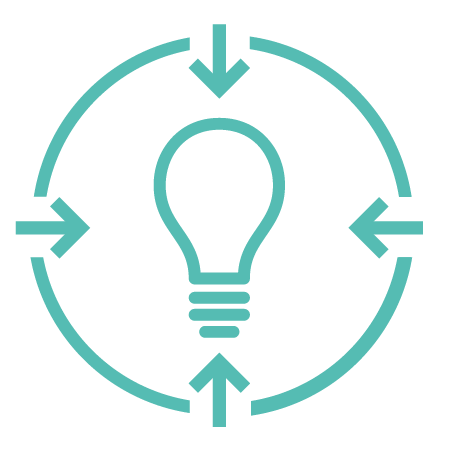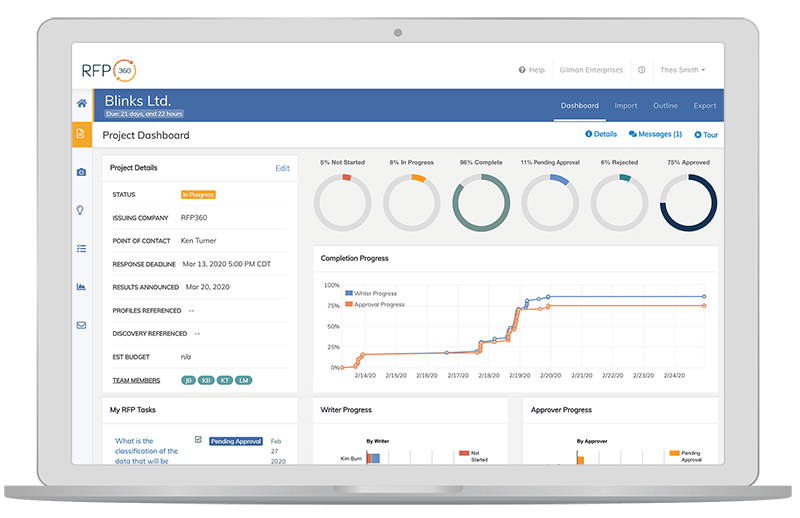Responding to requests for proposals (RFPs) is often cumbersome and time-consuming, which is why many organizations look for an RFP tool to streamline the response process. However, deciding which RFP response tool will be best for your needs can be tricky.
Below, we’ll cover everything you need to know about RFP tools. We’ll start with what an RFP tool is and which features are most important. We’ll also explore the non-feature factors that you should consider before making an RFP tool purchase.
- What is an RFP tool?
- 4 RFP response tool must-have features
1. A powerful RFP knowledge library
2. Automation capabilities
3. Workflow and collaboration tools
4. Dashboards and reporting
- Non-feature factors to consider before investing in an RFP tool
What is an RFP tool?
Certainly, there are lots of RFP tools and resources available. But, when people talk about investing in an RFP tool, generally they mean RFP software. Cloud-based RFP software solutions eliminate inefficiency in the RFP process by centralizing previous response content and automating proposal creation.
Unlike other RFP tools that only improve one area of the proposal process, RFP management technology delivers value from beginning to end. Brandon Fyffe, business development associate at CareHere, explains:
“There’s a lot of workarounds for not having RFP management software, but they’re just not the right tool for the job. You need something that’s specifically made for RFP responses.”
RFP software incorporates knowledge management, collaboration and project management best practices within the RFP process. With all of these features combined in a single RFP tool, the ROI for RFP software is impressive.
Explore how to calculate the value of RFP software in this ebook. Download now.
4 features to look for in an RFP response tool
When you’re on the hunt for an RFP tool to make your process easier, there are a few things you need to consider. On the surface, most proposal tools may seem very similar. However, when you dig a little deeper the differences will help determine which is the best fit for your team. So, let’s explore each of the four key features that deliver the most value to your RFP response process.
1. A powerful knowledge library
The best RFP tools start with a powerful knowledge library. In fact, most activities that occur in the RFP response tool will be connected to or centered around the answer library. Sometimes called a proposal content repository, it should be packed with tools and features that make it easy to manage and use. When evaluating the knowledge library it’s crucial to consider: searchability, extensions and integrations, as well as trackability and access.

Searchability
For RFP teams, one of the biggest challenges is finding previously-used content. Leveraging existing content saves a ton of time when responding to an RFP. Therefore, the knowledge library where that information is stored, must be highly organized. In fact, I would say that the knowledge library is the core of your RFP tool. It absolutely must be easy to add to, organize and search.
In an RFP response tool case study, Beverly Blakely Jones from National Geographic Learning |Cengage explained her first-hand experience with this challenge saying:
“It all came to a head as managers kept getting kickback. The product SMEs [subject matter experts] and marketing team were tired of answering the same questions over and over. They knew there had to be an easier way to manage our RFP responses.”
A knowledge library solves this challenge. However, if users can’t find the answers they’re looking for quickly, the knowledge library won’t do any good. So, I suggest looking for a tool that offers tags and account hierarchies to make managing the proposal content repository easy. In addition, an RFP tool that leverages artificial intelligence (AI) to find the right answers saves a ton of time.
Ant Cousins, director of customer success at ProFinda, suggests AI may not just be beneficial, but necessary to ensure users can find the information they need, even if they lack the knowledge needed to search effectively. In an article on Medium, he says:
“If employees don’t know how to do something, chances are they’re not going to be great at phrasing their requirements. Poorly worded questions mean poor searches and therefore poor responses … AI can now help us ask better questions by analyzing previous questions and comparing profiles in the same way that dating websites and media platforms ‘suggest’ or ‘recommend’ results to us. The data is there, we just need the platforms to access it.”
Extensions and integrations
From time to time you may need to find answers or information outside of your RFP response tool. Likewise, you may need to leverage information from the knowledge library when you’re working in other programs. This means that integrations and extensions are key to getting the most value out of your RFP management system.
Ensure your RFP tool works well with the programs that are already a part of your RFP process. For example, if you often answer proposals in web-based RFP portals, Chrome and Firefox knowledge library extensions would save a ton of time. Similarly, the ability to access your knowledge library while working in Office applications, like Excel and Word, can extend the RFP tool’s value. With the right integrations and extensions, you can use the knowledge library to also respond to security questionnaires as well as due diligence questionnaires.
Access control and trackability
Ideally, the knowledge library centralizes all of your response content, making it easy to find and use. However, in the real world, not everyone in your business should have unrestricted access to all of the information contained there. That is why data trackability and access control becomes vital when considering the right RFP response software for your business.
To get the most value possible from your RFP response tool, you need one that will allow users to focus on only the information they need to access. Therefore, it’s best to look for a tool that enables you to create custom account hierarchies and subaccounts. Then, each user can view and manage only the content they are responsible for.
In addition to access control, an RFP tool with change tracking, automatic audit trails and usage data can also save time and reduce risk. As answers are customized to meet the needs of each new RFP, the ability to see new changes and historical content helps executives review and approve proposals quickly. This way, everyone can see who wrote the answer, who updated it, when it was last used and more. These tools help to ensure that each proposal is accurate, compelling and up to date.
2. Automation capabilities
Manual RFP response processes are time consuming and costly. As digital transformation brings efficiency to the proposal process, opportunities for automation abound. When considering the best RFP tool for you, it’s wise to explore how RFP automation can be incorporated into your process.

Proposal completion
One of the most powerful ways automation saves time is by assisting with proposal completion. While no two proposals are ever exactly alike, chances are good that each new proposal shares a number of very similar questions. For example, almost all proposals will ask for your company’s background, experience, security information and so on.
In most cases, around 60 percent of RFP questions can be answered using answer intelligence (AI) that identifies the key phrases in the questions. Then, it suggests the best answer from your previous proposal content. By automating the search for answers, the proposal manager can spend more time tailoring the response. The customization of content makes the proposal even more compelling.
Reminders
In addition to faster RFP completion, automation can help keep your team organized and on track. In the highly-competitive world of sales and RFPs, providing an out-of-date answer or missing a deadline simply isn’t an option.
Kc Agu, a consultant, public speaker and freelance writer, is a believer in automated reminders. In an article on Entrepreneur, he discussed this all too common challenge saying:
“I cannot tell you how many times I have failed to deliver for certain clients simply because I did not put in place a system to remind me. I have since learned the power of reminders.”
Certainly, we’ve all been there. Indeed, a timely reminder can be a lifesaver. Make sure to find an RFP response tool that includes automated reminders so you can easily keep on schedule.
3. Workflow and collaboration tools
Your RFP process likely includes a number of key stakeholders. And, getting input from all of the necessary parties on time is a challenge. The team members involved in your process likely include SMEs, proposal writers, proposal managers, marketers, product and sales, just to name a few. No matter how each person contributes, they all need to work together.
Workflow and task tools
The right RFP management system will empower a more efficient workflow and seamless collaboration while offering a clear view of the group’s progress. Based on your project, some workflows and tasks can be assigned automatically. Your RFP response tool should enable you to assign tasks to both internal and external users. Users can then jump in and create content, contribute comments, review responses and approve changes simultaneously.

The proposal tool creates an easy-to-follow project plan and defines responsibilities. Everyone involved can clearly see the proposal’s progress. Then, the project manager can proactively identify any potential hurdles or bottlenecks. These workflow tools improve your chances of successfully completing your proposal on time.
Collaboration
Proposal teams often report the biggest issue with manual RFP tools is version control. Anyone that has worked in tools like Excel and Outlook knows how hard it is to keep track of who has the most up-to-date version. In her case study, Beverly Blakely Jones explains:
“Having multiple versions of several RFPs floating through inboxes was just a mess.”
The uncertainty can easily derail your progress. Fortunately, Beverly and her team found an RFP management system that was the perfect fit and eliminated version control issues. She explained:
“It’s much more efficient and cleaner than managing RFPs via email … There’s no version confusion, and we can make sure content was updated and approved recently.”
This centralized collaboration allows your entire team to work on a single document — from any location, at any time. After all, responding to RFPs is a team effort.
4. Dashboards and reporting
Everyone on your team is busy. So, an easy-to-read dashboard can make a world of difference when it comes to keeping your team on the same page. Data visualizations of your progress, upcoming tasks and more are powerful. Indeed, data is a huge part of the value of adopting an RFP response tool.

The benefits that data can deliver are endless. Reports created from your data can uncover valuable insights. For instance, data from your RFP management system can uncover a more efficient process. It can help you identify trends in procurement and empower business strategically adapt to the demands of your potential customers. Data from your responses can enable the marketing team to hone their message to create even more compelling RFP responses. Finally, data can also help track the time savings and value of the proposal tool itself.
Non-feature factors to focus on
There’s more to selecting the right RFP response tool than a checklist of features. Indeed, an RFP tool that neglects thoughtful design and user experience in favor of fast, flashy features will frustrate users in the long run. So, before buying an RFP tool consider these key non-feature factors.
Usability
When selecting your RFP response software, keep in mind that not every user will interact with it daily. Some subject matter experts and executive stakeholders will only need to login once every now and then. For that reason, usability must be one of your biggest priorities. Otherwise, your process will be slowed considerably and adoption of the tool will fall short of your expectations.
Experience and reliability
Cloud-based subscription services offer businesses the benefit of technology without all of the cost and upkeep. Accordingly, Software as a Service (SaaS) RFP tools deliver regular updates and enhancements. Ensure that the RFP management software you select has the skill and vision to deliver genuinely useful features that are reliable.
Customer experience
Your RFP software should come with a dedicated customer success team. From onboarding and implementation to ongoing support and periodic check ins, you should feel connected and empowered. The customer success team should be friendly, knowledgeable about your business and committed to helping you achieve your goals. That way, when you need support, you know exactly who to turn to.
Affordable scalability
Ideally, technology will make your proposal team more efficient and effective. That means, you will now have time to find and answer more RFPs. Consider the flexibility and structure of your RFP response software’s pricing. If your team decides to increase the number of RFPs they respond to by 10 percent, will you have to go back to your business for more budget? Likewise, if you undertake a huge project that requires input from double your number of typical users, will you have to buy more licenses? For these reasons and more, we recommend finding an RFP management system that offers unlimited users, projects and storage. Afterall, growth is the goal!
Additional use cases
Your RFP response software shouldn’t be a one-trick pony. In addition to RFPs, the software should be applied to any question-and-answer style document. Consider how the tool can be used to quickly answer security questionnaires, due diligence questionnaires (DDQs) and more. Also, does the RFP response tool also have an issuing solution for procurement teams?
Why picking the right RFP tool matters
An RFP response tool can simplify your proposal process … as long as you choose the right solution. So, ditch manual RFP tools like Excel and Outlook and switch to a solution that offers a powerful knowledge library, automation opportunities, workflow and collaboration tools as well as dashboards and reporting features. The right tool will empower your team to create more effective proposals and more successful outcomes even faster.
And, when you’re ready to take the next step, check out this business case for RFP software.

